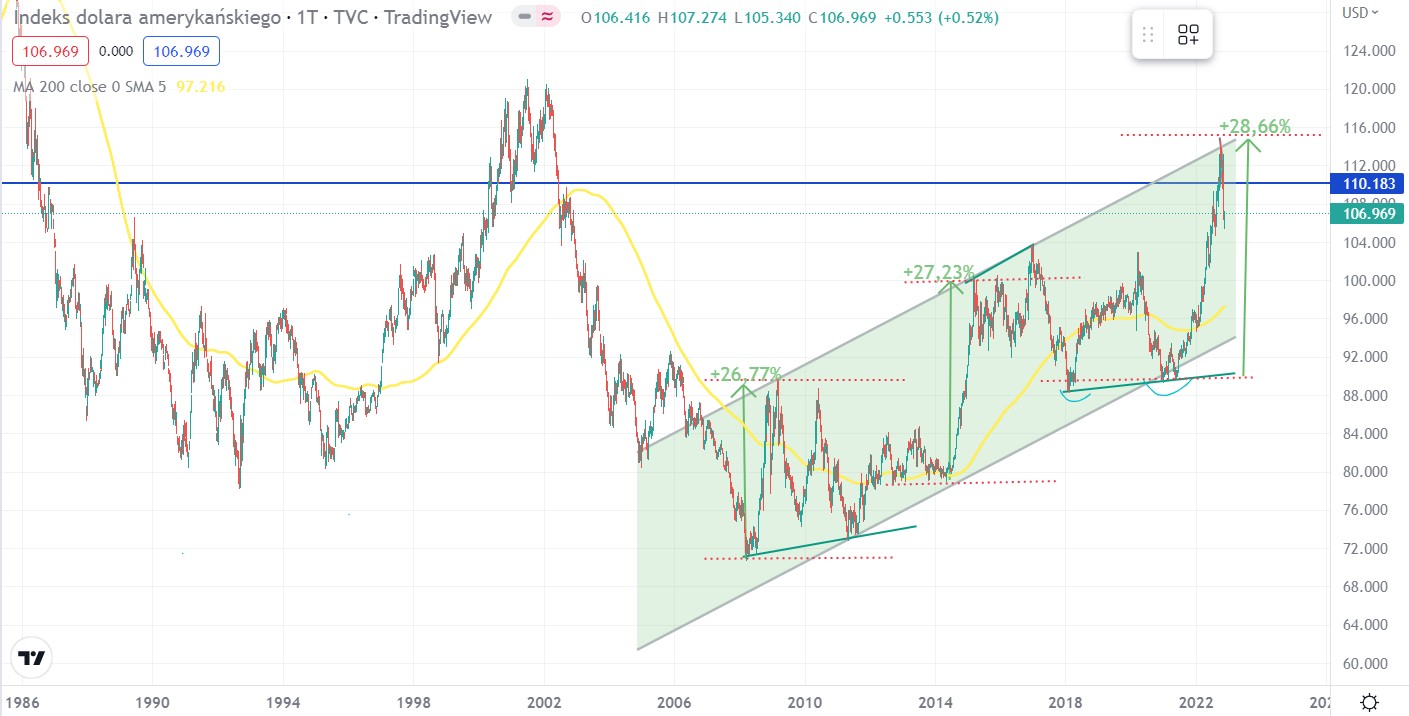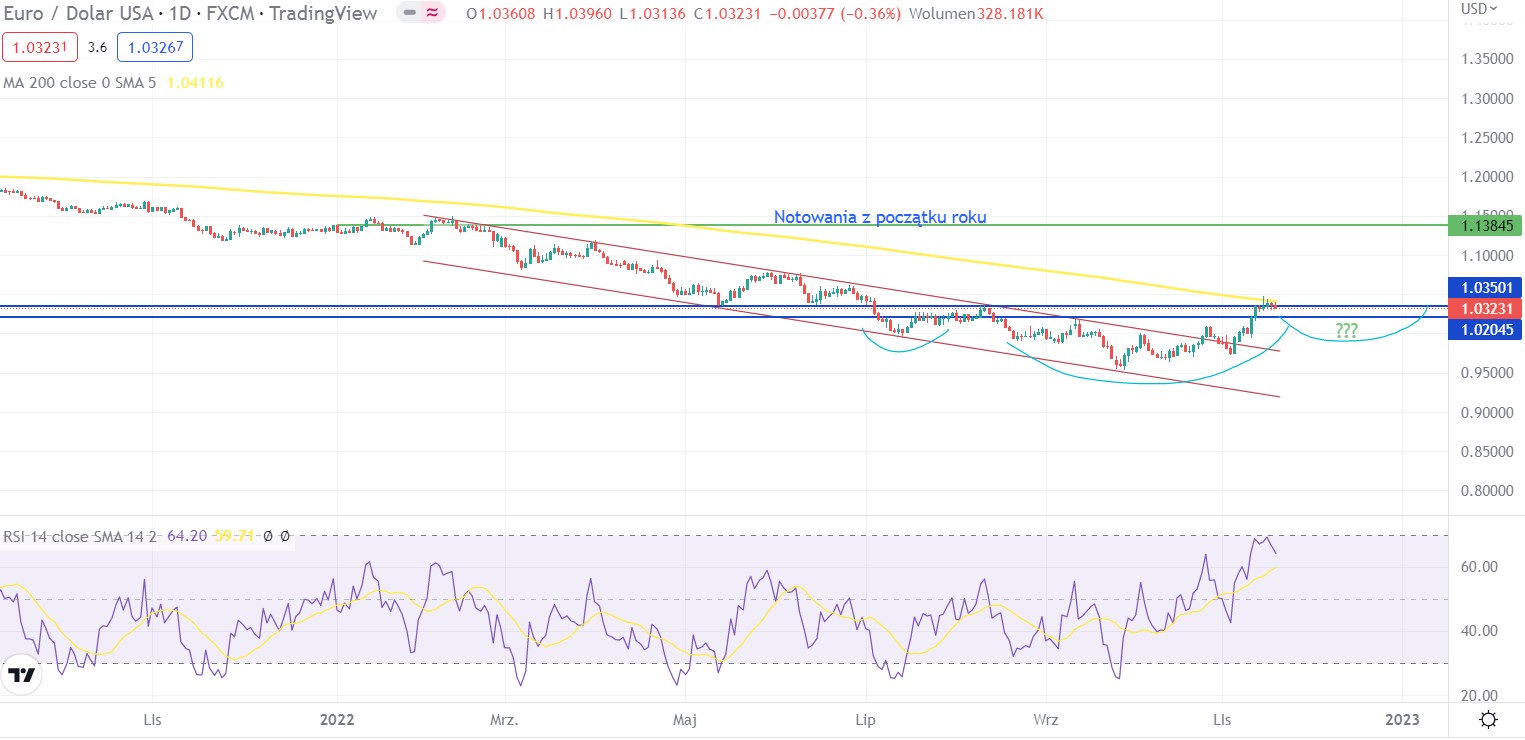The dollar index (DXY) broke its downward trajectory and managed to return to around 107 points. However, this does not change the fact that there is a positive sentiment on the market, which hinders the fight against inflation and supports the listing of the single currency. So, has the dollar reached its peak and we are facing a thaw, or maybe the announcements of one of the FED members, James Bullard, are a signal that Is the Fed seriously considering a 5-7% interest rate that would push the dollar to new all-time highs?
DXY once again hit the upper limit of the ascending channel
The cycles of the global dominance of the US dollar as measured by the DXY index remain volatile, with a move of 27 points. percent seems to be the norm. After every last cycle. starting in 2006, there were large swings that eventually formed a peak and started a new downward trend. The current uptrend on DXY has reached the top of the channel, having strengthened by 28.66% since January 2021, and we are currently seeing steep declines that are over 7% from the peak.
 DXY quotes on a weekly basis. Source: TradingView If history repeats itself, we may see another rebound, but before that happens, expect sharp swings, as well as a possible rebound in the 105 point area. However, it cannot be ruled out that in 2023 we will observe a further sell-off of the dollar, which may throw DXY quotes around the 100-point barrier.
DXY quotes on a weekly basis. Source: TradingView If history repeats itself, we may see another rebound, but before that happens, expect sharp swings, as well as a possible rebound in the 105 point area. However, it cannot be ruled out that in 2023 we will observe a further sell-off of the dollar, which may throw DXY quotes around the 100-point barrier.
The downward trend in the euro has been broken
In turn, looking at the EUR/USD quotes in the daily interval, we see that the currency pair has successfully broken out of the downward channel lasting since December 2021 and a possible shallow correction, it may be getting ready for further increases.
 EUR/USD quotes Source: TradingView From a technical point of view, the euro’s downtrend has been at least temporarily suspended, which means that in late 2022 or early 2023, the euro has a chance to test multi-month highs of 1.05. Earlier, however, we may witness the realization of the head and shoulders formation, and thus, if the quotes fall and stay around the parity, it may result in a further rebound, which should result in the quotes breaking around 1.0750 – 1.0935/ 1.10 and possibly up to 1.12.
EUR/USD quotes Source: TradingView From a technical point of view, the euro’s downtrend has been at least temporarily suspended, which means that in late 2022 or early 2023, the euro has a chance to test multi-month highs of 1.05. Earlier, however, we may witness the realization of the head and shoulders formation, and thus, if the quotes fall and stay around the parity, it may result in a further rebound, which should result in the quotes breaking around 1.0750 – 1.0935/ 1.10 and possibly up to 1.12.

Everything is in the hands of the Fed
The above scenarios are possible if the Fed decides not to increase interest rates even more. This year, the FED has already raised the interest rate by 5.9 percentage points (about 1 percentage point of growth ahead of us), but this is not visible in the economy. Moreover the American consumer is in pretty good shape, looking at the size of its expenses (which are to increase in real terms in Q4 2022 by as much as 4.8%). What’s more, the Fed is not receiving any alarming signals from the labor market lagging behind the economy, and this is because it looks at data slightly different from the realities of the average American. After the receding inflation, the labor market will soon begin to line up with dovish arguments, but of much greater importance from the point of view of the struggle to maintain the electorate. Of the two evils, income with declining purchasing power is better than no income at all. However, if inflation persists, J. Bullard, the current voting member of the FOMOC, said that the Fed rate should eventually rise to “sufficiently restrictive” levels of 5% to even over 7%, which he illustrated in his presentation “Gettinginto the Zone”. The range was calculated based on variants of Taylor’s principle, an equation proposed by the well-known economist John Taylor of Stanford University. The Taylor Principle is widely accepted in the economist community and shows where the Fed’s reference rate should be based on the current state of the economy. The materialization of such a scenario would, in turn, mean further, unrivaled dominance of the dollar on the broad market and farewell to hopes for a thaw, but it would have to lead to a recession.
The author also recommends:
Follow us on Google News. Search for what is important and stay up to date with the market! Follow us >>

